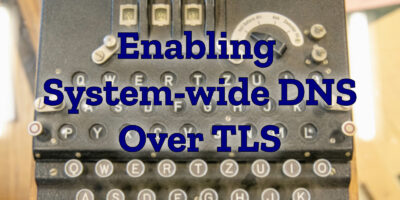The Fedora CoreOS team is pleased to announce that Fedora CoreOS is now available for general use. Here are some more details about this exciting delivery.
Fedora CoreOS is a new Fedora Edition built specifically for running containerized workloads securely and at scale. It’s the successor to both Fedora Atomic Host and CoreOS Container Linux and is part of our effort to explore new ways of assembling and updating an OS. Fedora CoreOS combines the provisioning tools and automatic update model of Container Linux with the packaging technology, OCI support, and SELinux security of Atomic Host. For more on the Fedora CoreOS philosophy, goals, and design, see the announcement of the preview release.
Some highlights of the current Fedora CoreOS release:
- Automatic updates, with staged deployments and phased rollouts
- Built from Fedora 31, featuring:
- Linux 5.4
- systemd 243
- Ignition 2.1
- OCI and Docker Container support via Podman 1.7 and Moby 18.09
- cgroups v1 enabled by default for broader compatibility; cgroups v2 available via configuration
Fedora CoreOS is available on a variety of platforms:
- Bare metal, QEMU, OpenStack, and VMware
- Images available in all public AWS regions
- Downloadable cloud images for Alibaba, AWS, Azure, and GCP
- Can run live from RAM via ISO and PXE (netboot) images
Fedora CoreOS is under active development. Planned future enhancements include:
- Addition of the next release stream for extended testing of upcoming Fedora releases.
- Support for additional cloud and virtualization platforms, and processor architectures other than x86_64.
- Closer integration with Kubernetes distributions, including OKD.
- Aggregate statistics collection.
- Additional documentation.
Where do I get it?
To try out the new release, head over to the download page to get OS images or cloud image IDs. Then use the quick start guide to get a machine running quickly.
How do I get involved?
It’s easy! You can report bugs and missing features to the issue tracker. You can also discuss Fedora CoreOS in Fedora Discourse, the development mailing list, in #fedora-coreos on Freenode, or at our weekly IRC meetings.
Are there stability guarantees?
In general, the Fedora Project does not make any guarantees around stability. While Fedora CoreOS strives for a high level of stability, this can be challenging to achieve in the rapidly evolving Linux and container ecosystems. We’ve found that the incremental, exploratory, forward-looking development required for Fedora CoreOS — which is also a cornerstone of the Fedora Project as a whole — is difficult to reconcile with the iron-clad stability guarantee that ideally exists when automatically updating systems.
We’ll continue to do our best not to break existing systems over time, and to give users the tools to manage the impact of any regressions. Nevertheless, automatic updates may produce regressions or breaking changes for some use cases. You should make your own decisions about where and how to run Fedora CoreOS based on your risk tolerance, operational needs, and experience with the OS. We will continue to announce any major planned or unplanned breakage to the coreos-status mailing list, along with recommended mitigations.
How do I migrate from CoreOS Container Linux?
Container Linux machines cannot be migrated in place to Fedora CoreOS. We recommend writing a new Fedora CoreOS Config to provision Fedora CoreOS machines. Fedora CoreOS Configs are similar to Container Linux Configs, and must be passed through the Fedora CoreOS Config Transpiler to produce an Ignition config for provisioning a Fedora CoreOS machine.
Whether you’re currently provisioning your Container Linux machines using a Container Linux Config, handwritten Ignition config, or cloud-config, you’ll need to adjust your configs for differences between Container Linux and Fedora CoreOS. For example, on Fedora CoreOS network configuration is performed with NetworkManager key files instead of systemd-networkd, and time synchronization is performed by chrony rather than systemd-timesyncd. Initial migration documentation will be available soon and a skeleton list of differences between the two OSes is available in this issue.
CoreOS Container Linux will be maintained for a few more months, and then will be declared end-of-life. We’ll announce the exact end-of-life date later this month.
How do I migrate from Fedora Atomic Host?
Fedora Atomic Host has already reached end-of-life, and you should migrate to Fedora CoreOS as soon as possible. We do not recommend in-place migration of Atomic Host machines to Fedora CoreOS. Instead, we recommend writing a Fedora CoreOS Config and using it to provision new Fedora CoreOS machines. As with CoreOS Container Linux, you’ll need to adjust your existing cloud-configs for differences between Fedora Atomic Host and Fedora CoreOS.
Welcome to Fedora CoreOS. Deploy it, launch your apps, and let us know what you think!






Artur
Good news, as current user of Atomic version I’m happy hear that 🙂
Brad Smith
Will there be guidelines on how to use vagrant to run Fedora CoreOS ? There also utilities for Fedora CoreOS such as the fcct transpiler. Are there plans to provide rpms for these tools so that they can be managed on a fedora workstation like other software components?
thanks
Dusty Mabe
Hey Brad,
We currently aren’t producing any Vagrant images for Fedora CoreOS, but we are still working to enable platforms, so hopefully we’ll add a vagrant image for someone with a vagrant setup to easily spin up and poke around Fedora CoreOS. Regarding FCCT, yes we’d like to get an RPM into the repos. See https://github.com/coreos/fcct/issues/14.
Dusty
Jack
As an openSUSE Kubic user I really looking forward to try this one.
Brad Smith
Thanks Dusty. Bas vd Lei updated the tool he developed to produce a vagrant image for FCOS so that is working for me at the moment. See https://discussion.fedoraproject.org/t/playing-around-with-fedora-coreos-using-vagrant-libvirt-on-fedora-silverblue/1704/11 for links. I appreciate all the work being done for FCOS.
David
As a Workstation user I likely will never have a use for this. However if I did I would have a huge problem with the idea of automatic updates as default behavior. I’ve jut seen too many installations brought down by auto updates, Those where running Windows but that makes little difference.
No maybe I’m just misinformed but that highlights the idea that we need to see more about CoreOS in this magazine and other venues
Dusty Mabe
Thanks David. I appreciate your thoughts here. Attempting to automatically update things is a bold endeavor. In addition to the automated tests we run we’ll also need help from users to run the testing stream on part of their deployments to help us (and them) identify when a future update to the stable stream is likely to break things. We really can’t do it without having an engaged user community that is willing to help us identify problems and also commit those likely break points back in to our automated testing.